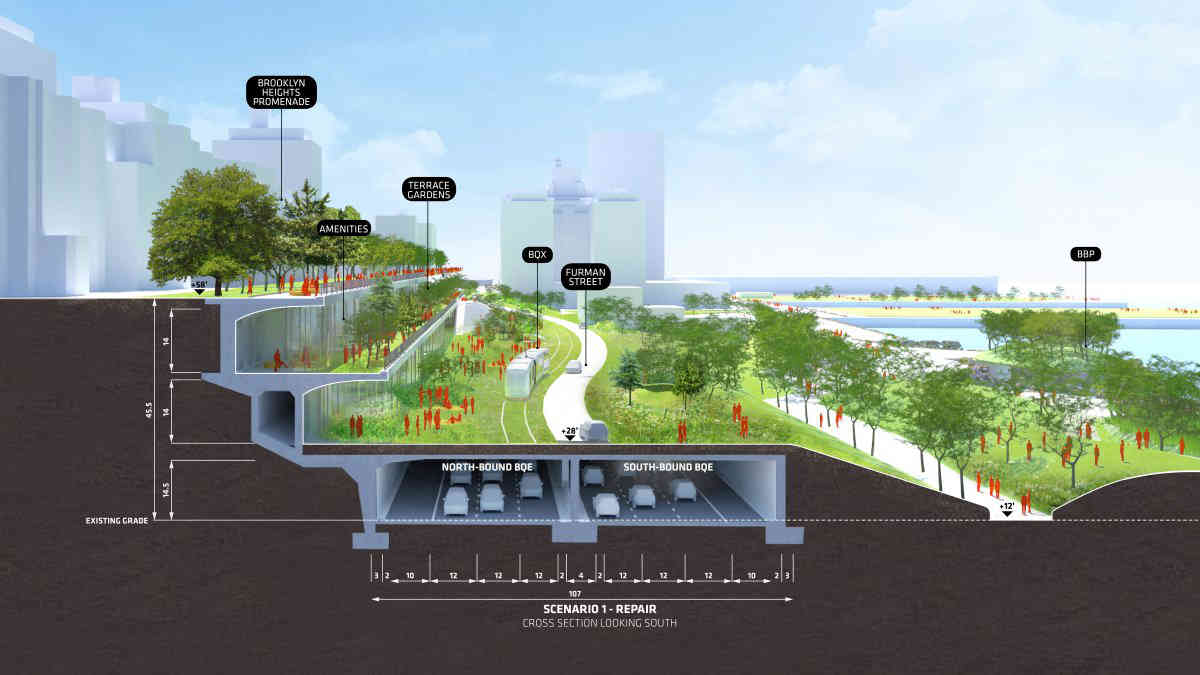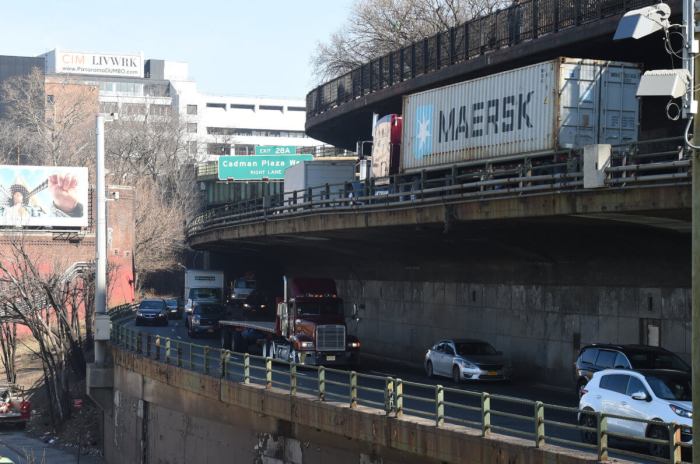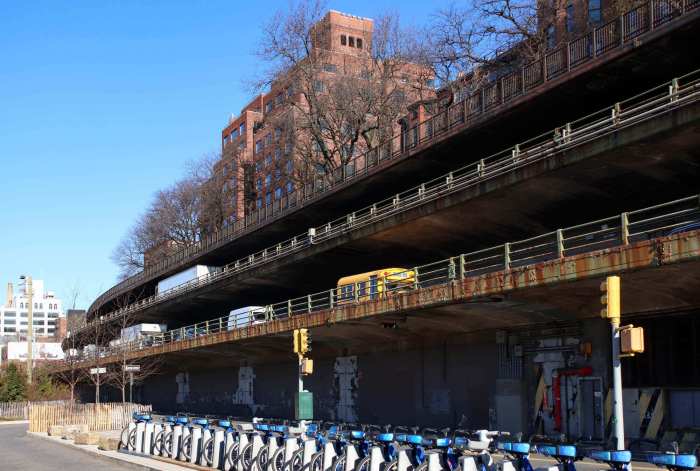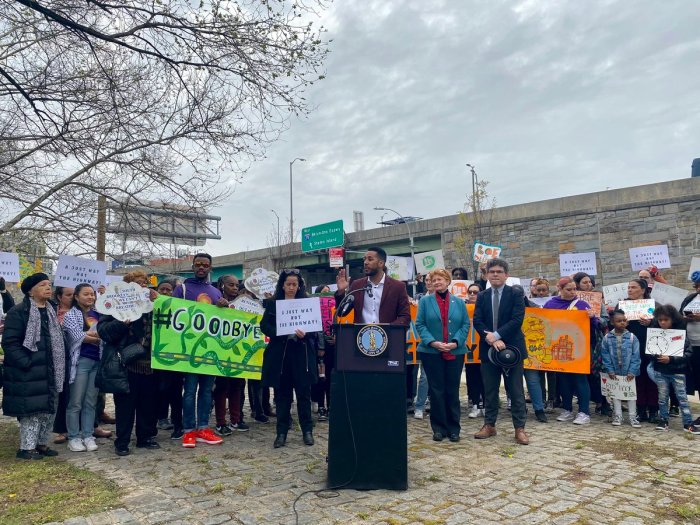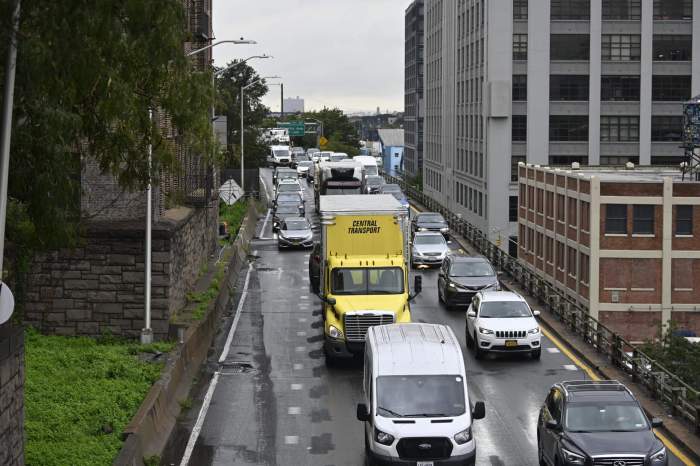Call it the BQP!
A world-famous architecture firm has proposed to turn the Brooklyn-Queens Expressway into an ambitious 10-acre park on top of a capped highway, calling it the Brooklyn-Queens Park — or BQP.
Architects with the Dumbo-based Bjarke Ingels Group on Tuesday released a plan — which they produced pro-bono — to build a six-lane highway along the back of Brooklyn Bridge Park on Furman Street at ground level, and cap it off in order to build a new park on top.
The designers proposed to spare the beloved Brooklyn Heights Promenade and repurpose the existing cantilever into either a tiered park – similar to the “Tri-line” park idea proposed by Heights local Mark Baker – or demolish the two lower levels and recycle the debris into an artificial cliff side if the aged structure proves too expensive to retain, according to the firm’s planner spearheading the proposal.
“We would be able to use the BQE rubble to create a newly-reconstructed cliff side, naturalized, with [Americans with Disabilities Act] ramps, bringing you down and connecting from the Brooklyn Heights Promenade to Brooklyn Bridge Park in a way that it hasn’t been for a long time,” said Jeremy Alain Siegel.
The new park could also allow for Mayor de Blasio’s beloved Brooklyn-Queens Connector to run along the lowest level, next to a two-lane Furman Street for cars, as well as an indoor parking garage underneath the promenade, renderings show.
Engineers from the firm’s partner organization Arcadis deemed that theirs is the most straightforward way to deal with the reconstruction because builders would only have to construct a new roadway once without having to take it back down afterwards, and the road would be at ground level instead of the city’s proposed 50 feet height — possibly making it a cheaper and faster process, according to the architect.
“We think that we could very likely do this at the same or a reduced timetable and also at the same or reduced cost,” he said.
Siegel and his team are considering extending the park to the Cobble Hill trench section of the roadway at Atlantic Avenue, which could even allow for a future walkway from Brooklyn Bridge to Red Hook if the city decides to cap that trench, according to the Brooklyn Heights resident.
“If you were able to do that you would be creating a linear park that connects you from the Brooklyn Bridge all the way to Red Hook, which would be quite an amazing thing,” Siegel said.
The firm’s founder, Bjarke Ingels, will also be moving to the upscale Heights soon, according to Siegel, so he could end up having his own company’s creation in his back yard.
The only difficulty with their plan is that the city agency would have to go beyond their remit and partner with the state and Brooklyn Bridge Park, but Siegel believes that a plan as convincing as theirs could gather enough public support and momentum to spur the departments into action and overcome bureaucratic hurdles.
“They have a critical life safety on their hands, they want to make sure the whole thing doesn’t get snagged in approvals and coordinations and so they’ve been trying to stay as much in DOT right-of-way and DOT jurisdiction as possible,” he said. “If people can really come around to that idea then that coordination will not be such a headache, it will be something that is demanded and something that has to happen to make the right decision here.”
The project group designed the proposal to accommodate the same amount of traffic that the department planned for, but planners may be able to reduce the road to four lanes if traffic flow decreases as a result of new statewide policies, according to a new report by a Tri-state research organization.
The Regional Plan Association, which worked together with Bjarke Ingels Group on the BQE plan — and also has a rep on the mayor’s new expert panel for the project — released a report on April 2 that five policy changes could reduce traffic on the roadway.
The association’s report argues that the state’s recently-approved congestion pricing, along with their proposed high occupancy vehicle policies, splitting bridge tolls equally for both directions, and reducing lanes will decrease traffic by as much as 25 percent during the expressway’s reconstruction.
Siegel said his team took the report’s numbers into consideration but said that their plan would work even if the current vehicle volumes persist.
“We wanted to prove the feasibility of a six-lane configuration in the case that that would be what was deemed necessary. However, if we are able to reduce to five or four lanes as RPA has been proposing, it would make this scheme just that more feasible and less expensive,” he said.
